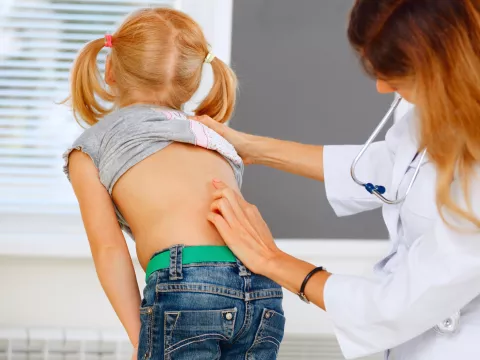- AdventHealth

Affecting about 3% of children under the age of 16, scoliosis is the most common spine condition in young people. Scoliosis is a sideways curvature of the spine that most often occurs during a child’s growth spurt, just before puberty.
It is a common misconception that heavy book bags, lack of exercise and slouching contribute to this spine condition.
Most cases are what doctors call idiopathic, which means they don't know what the cause is. In other words, parents, don’t put blame on yourself if your child has scoliosis, as there is no known way to prevent the disorder.
However, there does appear to be a genetic component involved. So, if your child has scoliosis, their siblings may be more likely to have it, too.
Raymund Woo, MD, AdventHealth for Children Medical Director of Pediatric Orthopedic Surgery, shares more on the symptoms and treatment options for kids living with scoliosis so you can help your child minimize any mental or physical issues that may come along with a scoliosis diagnosis.
What are the common symptoms of scoliosis parents should watch for?
Most cases of scoliosis don’t have any symptoms at all. Much like children with slight hearing or vision changes, early cases can be missed. Your pediatrician and school nurse should perform scoliosis screening as part of their annual wellness visit.
How young can a child show symptoms or be diagnosed?
Most cases of scoliosis are diagnosed after age 10, when the child is in 4th or 5th grade. However, there are cases were scoliosis is seen in younger children and even infants. Many of these cases have no symptoms, but children can have problems with back pain, neck pain, headaches, leg weakness, and changes in their bowel or bladder habits.
Are children still screened for scoliosis by schools or only their pediatrician?
School screening varies widely. Private schools may not incorporate this as part of their normal school nurse program. Public schools can have a school screening policy if it is approved by their county school board. However, scoliosis screening is part of every child’s regular yearly checkup with their pediatrician.
How important is it to detect scoliosis early, and how can early detection benefit kids?
Early detection and treatment are the key to treating scoliosis because it can prevent spinal fusion surgery. If detected early, scoliosis can be treated by therapy or bracing. In particular, bracing has been proven to work in 85% of patients with mild scoliosis.
What may happen if it is not caught early?
Scoliosis worsens as the child grows, so the faster the child grows, the faster the curve will worsen. If their curve is severe, your child will need surgery to have the spine fused. The goal is to catch scoliosis when it’s mild and avoid surgery through early intervention
What are short-term and long-term treatment options?
Treatment is divided into three categories: Bracing, observation and surgery.
Bracing is the most important component of short-term treatment. It works best on children who haven’t gone through puberty and is not useful after the child is skeletally mature. Generally, a child is considered to be mature at age 14 years for girls and 16 years for boys.
Observation is used for children who have a scoliosis curve that is too small for bracing, and older children who are not growing quickly. Most cases of scoliosis are treated with observation with a visit to the orthopaedic surgeon for spine x-rays every six months.
Surgery, while uncommon, is the only way to treat curves which are too large for bracing. There are many surgical options and new techniques which can be discussed with the orthopaedic surgeon.
Can a child fully recover from scoliosis?
Scoliosis is not a reversible disease, hence the need for early detection and treatment. Surgery is the only way to fully correct scoliosis but comes with risks and long-term effects. However, there is lots of long-term research showing that children who have spinal surgery have very good results at 45 years after their surgery.
How impactful is the genetic component of scoliosis?
The genetic component of scoliosis is a hot topic because we know that scoliosis is an inherited disease that predominantly affects girls. Currently, the gene(s) that cause scoliosis are unknown, but there are some associated genes that can be detected using a saliva sample, and a saliva test had been commercially available until recently. This saliva test was withdrawn from the market because it did not provide enough information to the physician.
Even so, the fact that scoliosis is genetically determined means that the cause and treatment have little to do with what the child does and does not do. So, while some may think heavy book bags or slouching can cause scoliosis, that is a common misconception. Similarly, there is little scientific evidence that physical therapy, exercise or nutrition will improve scoliosis.
More Information for Parents
There a lot of information on social media and the internet on scoliosis — but as with anything else, it may or may not be true and parents should be wary of the impressions they get from reading this information. Dr. Woo recommends discussing any concerns you have with a qualified pediatric orthopaedic spine surgeon.




